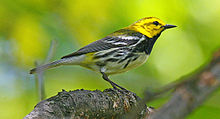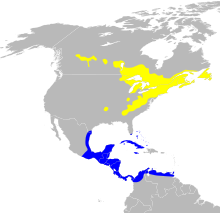
The yellow-rumped warbler is a regular North American bird species that can be commonly observed all across the continent. Its extensive distribution range connects both the Pacific and Atlantic coasts of the U.S. as well as Canada and Central America, with the population concentrating in the continent's northern parts during the breeding season and migrating southwards to southern North and Central America in Winter. The species generally prefers coniferous forests or mixed coniferous-deciduous forests as its breeding habitat, while during the winter it can be found inhabiting more open areas such as shrublands that offer food resources. The diet of the yellow-rumped warbler is based primarily on insects, though the species does eat fruits such as juniper berries as well, especially in winter.

The Cape May warbler is a species of New World warbler. It breeds in northern North America. Its breeding range spans all but the westernmost parts of southern Canada, the Great Lakes region, and New England. It is migratory, wintering in the West Indies. This species is a very rare vagrant to western Europe, with two records in Britain as of October 2013. The English name refers to Cape May, New Jersey, where George Ord collected the specimen later described by Alexander Wilson. This species was not recorded again in Cape May for another 100 years, although it is now known as an uncommon migrant there.
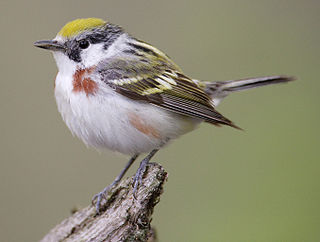
The chestnut-sided warbler is a New World warbler. They breed in eastern North America and in southern Canada westwards to the Canadian Prairies. They also breed in the Great Lakes region and in the eastern United States.

The yellow warbler is a New World warbler species. Yellow warblers are the most widespread species in the diverse genus Setophaga, breeding in almost the whole of North America, the Caribbean, and down to northern South America.

The bay-breasted warbler is a small species of songbird in the New World warbler family, Parulidae. It is one of thirty-four species in the diverse genus Setophaga. Like all songbirds, or passerines, the species is classified in the order Passeriformes.

The black-and-white warbler is a species of New World warbler, and the only member of its genus, Mniotilta. It breeds in northern and eastern North America and winters in Florida, Central America, and the West Indies down to Peru. This species is a very rare vagrant to western Europe.
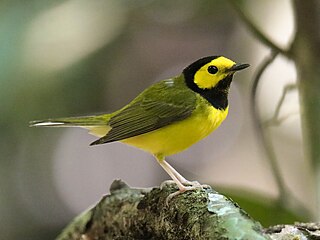
The hooded warbler is a New World warbler. It breeds in eastern North America across the eastern United States and into southernmost Canada (Ontario). It is migratory, wintering in Central America and the West Indies. Hooded warblers are very rare vagrants to western Europe.

The Tennessee warbler is a New World warbler that breeds in eastern North America and winters in southern Central America, the Caribbean, and northern South America. The specific name peregrina is from Latin peregrinus "wanderer".

The mourning warbler is a small songbird of the New World warbler family. Mourning warblers are native to eastern and central North America as well as some countries in Central America. They are neotropical migrants and tend to be found in dense second growth forests. They are under the Wood-warbler category, which consists of arboreal and terrestrial colorful passerines. Wood warblers are in the order Passeriformes, which are perching birds including more than half of all bird species, and the family Parulidae which also includes the Common Yellowthroat, Black and White Warbler, Nashville Warbler, ovenbird, and American Redstart. They are very similar to the MacGillivray's Warbler in appearance, especially in females and immature birds, but their breeding range does not overlap into the west.

The pine warbler is a small songbird of the New World warbler family.

The palm warbler is a small songbird of the New World warbler family.
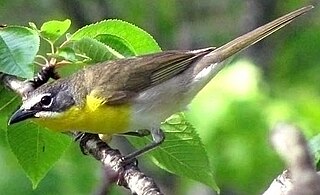
The yellow-breasted chat is a large songbird found in North America, and is the only member of the family Icteriidae. It was once a member of the New World warbler family, but in 2017, the American Ornithological Society moved it to its own family. Its placement is not definitively resolved.

The yellow-throated warbler is a small migratory songbird species in the New World warbler family (Parulidae) found in temperate North America.

The black-throated gray warbler or black-throated grey warbler is a passerine bird of the New World warbler family Parulidae. It is 13 cm (5.1 in) long and has gray and white plumage with black markings. The male has the bold black throat of its name, and black stripes on its head, as well as black streaks on its flanks; the female is a paler version of the male, with a white throat and less distinct black markings on the flanks and wings. It breeds in western North America from British Columbia to New Mexico, and winters in Mexico and the southwestern United States. The habitats it prefers are coniferous and mixed forests and scrubland, especially those with pinyon pines, junipers, sagebrush, and oaks. Its nest is an open cup of plant fibers lined with feathers, built a few metres from the ground in the branches of a tree or shrub. Three to five eggs are laid, and young are fed by both parents. Common in its breeding range, it does not seem to be seriously threatened by human activities, unlike many migratory warblers.

Townsend's warbler is a small songbird of the New World warbler family.

Grace's warbler is a small New World warbler that specializes in pine woods.

The hermit warbler is a small perching bird. It is a species of New World warbler or wood-warbler. They are a migratory bird, the breeding range spanning the majority of the west coast of the United States. Their winter range includes parts of Mexico and Central America as well as parts of the southern California coast.

Setophaga is a genus of birds of the New World warbler family Parulidae. It contains at least 33 species. The males in breeding plumage are often highly colorful. The Setophaga warblers are an example of adaptive radiation with the various species using different feeding techniques and often feeding in different parts of the same tree.
